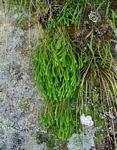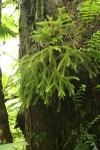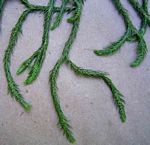Huperzia verticillata (L.f.) Trevis.
Synonyms |
Lycopodium verticillatum L.f. |
|---|---|
Common name |
|
Description |
Rooting stem 4-6 cm long; aerial stems pendulous, repeatedly dichotomously branched, 25-50 x 0.3-0.6 cm (apex 0.2-0.3 cm wide). Foliage leaves needle-like, 5-8 × 0.2-0.5 mm, with distinct midrib, firmly herbaceous, overlapping, mid- to dark green; grading into the almost indistinguishable fertile portion. Sporophylls similar to the sterile leaves, sporangia single, in the axils of the sporophylls mostly along the apical area of the stem, not hidden, 2-2.5 mm wide. |
Notes | H. verticillata has an indistinct fertile portion with sporophylls that are similar to the foliage leaves. |
Derivation | verticillatum: in whorls, referring to the whorled arrangement of the leaves on the stem. |
Habitat | Deep shade in intermediate and montane evergreen forest, Brachystegia woodland influenced by mist. |
Distribution worldwide | Africa, Madagascar, Comoro and Mascarene Islands, São Tomé and tropical America. |
Distribution in Africa |
Cameroon, Dem. Republic of Congo, Equatorial Guinea (incl. Bioko), Ethiopia, Kenya, Lesotho, Malawi, Mozambique, Rwanda, South Africa, Swaziland, Tanzania , Zambia, Zimbabwe. |
Growth form |
Epiphytic, lithophytic. |
Literature |
|



